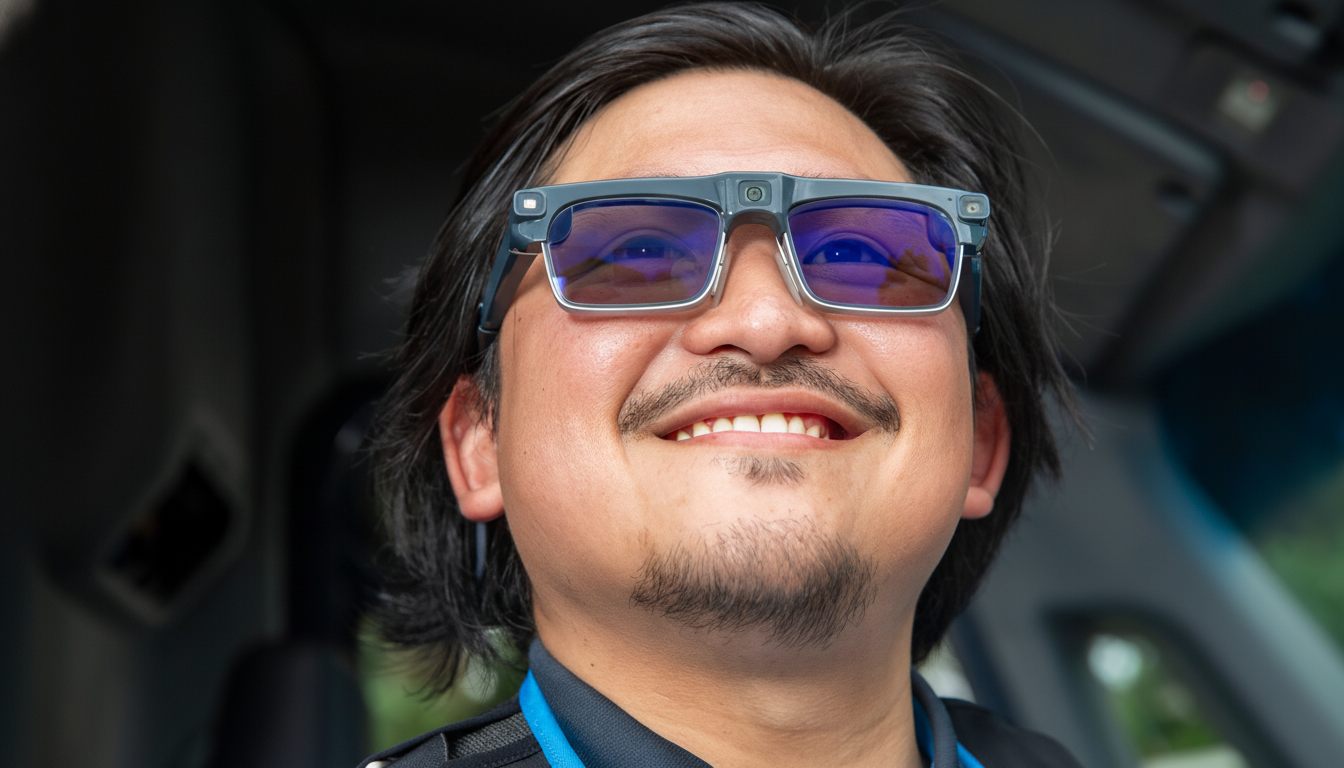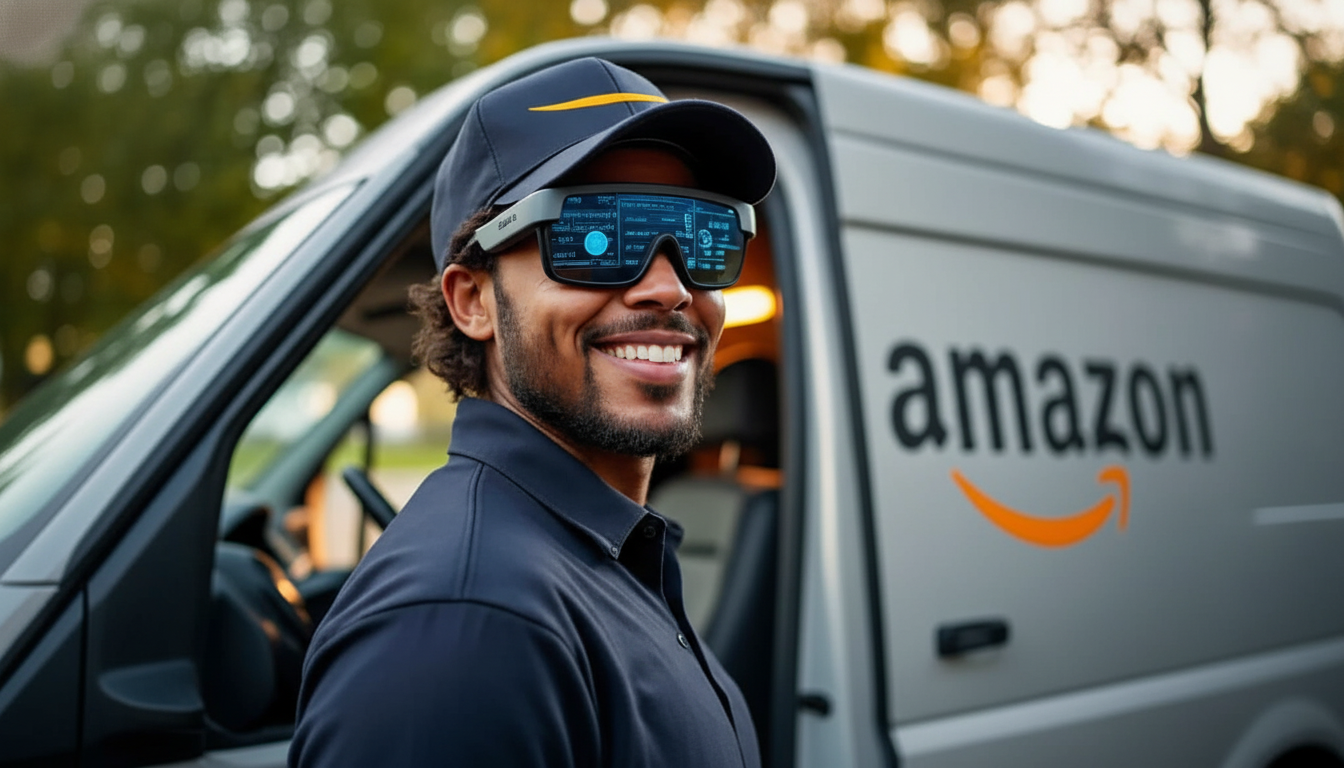Amazon is piloting smart glasses for its delivery workforce, betting that a heads-up display and on-device computer vision can shave seconds off every stop while reducing mistakes. The glasses guide drivers on foot to the doorstep, let them scan packages hands-free, and capture proof of delivery, according to early details shared by the company.
The eyewear supports prescription lenses and uses transitional optics that adjust to changing light. Rather than packing all electronics into the frames, Amazon pairs the glasses with a delivery vest that houses a controller, a swappable all-day battery, and an emergency button. The company has not announced timing for a broader rollout but says the system is already in field tests with employees.

How Amazon’s delivery smart glasses system works
When a driver reaches a stop, the glasses wake automatically and overlay prompts on a heads-up display. Using the built-in camera and computer vision, the wearer can scan a barcode and get an instant check that the package matches the address. That reduces device juggling and lowers the risk of mis-sorts at the curb.
For the final approach, the glasses provide turn-by-turn walking directions from the vehicle to the door, accounting for complex apartment layouts, side entrances, or multi-unit homes. The system is designed to flag hazards—think low-light pathways, staircases, or pets—before a driver reaches the doorstep. At handoff, the eyewear can record proof of delivery from the driver’s point of view, similar to the photo confirmations many customers already see in their order history.
Hardware details are still emerging, but early images suggest at least two cameras positioned on the frame. Offloading compute and power to the vest helps keep the glasses lighter, a key factor for comfort on routes that can stretch for hundreds of stops.
Why last-mile efficiency gains matter for Amazon
Last-mile delivery is the most expensive slice of logistics, often accounting for about 50% of total shipping costs in industry analyses. A few saved seconds per stop add up at Amazon’s scale. Across thousands of routes, trimming even 20–30 seconds can reclaim many thousands of labor hours daily and reduce vehicle idling and emissions.
Hands-free workflows have a track record in logistics. DHL’s “vision picking” pilots with smart glasses reported productivity gains of up to 25% in warehouses by speeding scanning and reducing errors. In route optimization, UPS’s ORION software cut roughly 100 million miles from annual driving, demonstrating how incremental efficiency composes into outsized savings. Amazon’s approach aims to combine these dynamics—less time per stop and fewer misdeliveries—right where costs are concentrated.
Safety and worker experience with wearable delivery tech
Hazard awareness is more than a convenience. Postal safety data routinely highlight dog encounters and slip-and-fall risks on residential routes; the U.S. Postal Service reported more than 5,800 dog-related incidents in a recent year. Proactive alerts about pets, low lighting, or obstructed paths could help drivers make safer choices and avoid injuries.

Comfort and endurance matter, too. Prescription support reduces the need to layer glasses, while transitional lenses limit squinting and eye strain as drivers move from bright sun to porches and hallways. A vest-mounted, swappable battery is a pragmatic nod to all-day use, and the dedicated emergency button offers a direct line for help—features drivers tend to value as much as raw speed.
The proof-of-delivery capability will draw scrutiny. Recording around private homes raises questions about data minimization, retention, and access. Privacy advocates have urged clear policies and guardrails for wearable cameras in public spaces. For adoption to scale, Amazon will need to spell out how footage is processed, how long it’s stored, and who can review it.
Competitive and industry context for logistics wearables
AR and assisted-reality wearables are already entrenched in logistics, with devices from Vuzix and RealWear in warehouses and scanners from Zebra and ProGlove streamlining pick-and-pack. Amazon’s twist is bringing a street-ready, glasses-first experience into the unpredictable world of residential delivery and tying it directly to navigation and proof-of-delivery workflows.
The pilot also lands amid broader automation efforts in fulfillment. Recent reporting has spotlighted heavy investment in robotics and raised concerns about long-term labor effects. Amazon has pushed back on projections of sweeping job losses, and these glasses are explicitly framed as augmentation for human drivers rather than a replacement—aimed at making each stop faster, safer, and more accurate.
What to watch next as Amazon pilots delivery smart glasses
Amazon says future versions could spot damaged parcels, flag wrong-address drops in real time, and expand hazard detection beyond lighting and pets. The metrics to watch will be stop duration, first-attempt delivery rate, injury frequency, and customer satisfaction scores. Gains in any one of these can justify rapid deployment.
If the pilots deliver, expect a phased rollout across Delivery Service Partners, especially before peak season. In a network that moves billions of packages annually, small improvements compound—turning a pair of glasses into a meaningful lever on cost, safety, and reliability in the last mile.

